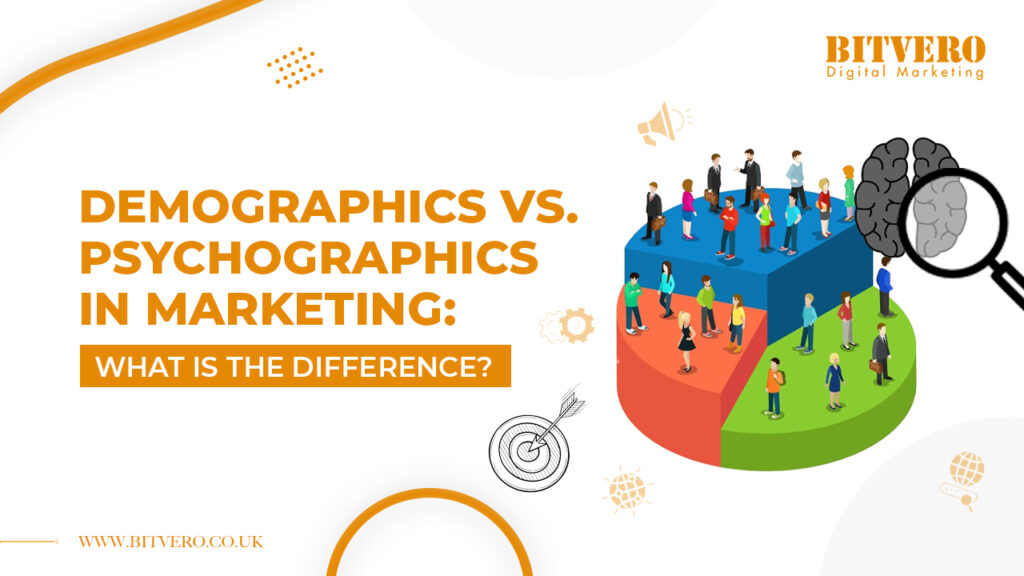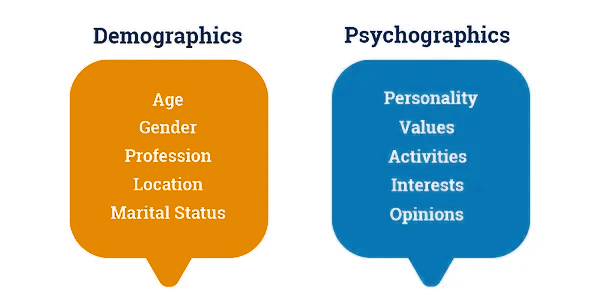Demographics vs. Psychographics in Marketing: What is the Difference?

When it comes to digital marketing, segmenting the audience becomes important.
Based on several factors, you identify who you should serve with your marketing campaign and name it your “target audience”.
However, within this target audience- there are two types of segmentations.
One is quantitative, while the other is qualitative, i.e., demographics and psychographics, respectively.
So, when you filter out your audience for the marketing campaigns, it becomes important to consider both parameters.
For that, knowing the clear difference between demographics and psychographics is very important.
Here, in this guide, we are going to do the same. We will know the difference between the two.
If you are still unaware of both, keep reading this article.
Demographics
Demographics are measurable features that you look at while filtering out your audience.
That means when you select an audience on the basis of parameters, you can count.
Typically, they are age, gender, income, education, occupation or even geographical location.
If you noticed, apart from being quantifiable, most of these characteristics also have objective features.
That means they are usually based on facts and have nothing to do with personal feelings or experiences.
Psychographics
Unlike demographics, psychographics are more about the subjective information you collect.
It is qualitative data and more personal when it is about choices, interests, values, lifestyle, behaviours, opinions and so on.
That means during Google PPC ads or social media marketing, when you place ads to people who in any way have shown interest (e.g., through search or liking posts) in a product or service similar to you, you are actually targeting them based on Psychographics.
Your website cookies do the same job. They collect for you this immeasurable but valuable information.
Demographics vs. Psychographics Example
Let’s say a company that sells beauty products goes for digital marketing services.
Its operating area is the United Kingdom.
Now, their target audience will be mostly women residing in the UK.
The company can also decide on income category if products are expensive. Also, the company can select age criteria if it is for specific age groups.
This way, the target audience is set based on demographics.

To further filter it, psychographics will come into the picture.
Continuing the same example, let’s understand how they will help.
Sure, the company sells beauty products. Of these products, some are animal cruelty-free or environment friendly.
Now, the company finds people who are conscious of ethical choices, even when it comes to beauty products.
Because they already have these values, they will genuinely show interest in your product and may become your customers even more potentially.
Ways to Understand Psychographics
When it is about targeting based on demographics, you can do so simply by selecting the age, gender, location, etc.
But the question remains there how to collect information based on psychographics?
For example, how do we get to know what people are interested in, what they prefer, and over what?
So, here are some ways to identify people based on psychographics to target your digital marketing campaign.
Social Listening
Social listening is the best way to understand people’s behaviour, opinions, and interests.
In social listening, you just need to listen to what people have to say on the internet.
Whether it’s a product, a service, a brand, or anything else, people talk about everything.
You just have to monitor and analyse what is about.
What do they prefer, and how do they react to trends in your industry,
There are a number of social tools like Brand24, Awario etc., you can use to fetch information for the same.
Survey & Polls
Another way to understand people’s interests is to conduct surveys or polls.
You can just ask people questions regarding their preferences.
On social media stories, you can ask followers questions or conduct polls.
Just for a simple example, “pizza or a burger, what is their choice” between the two?
Website analytics
Your website also helps you understand psychographics.
When people interact with it, their behaviour gets stored in the form of cookies and other information.
So, if users show more interest in your product compared to others, you will know that.
Tools like Google Analytics give you all the information.
Bounce rate, time spent on a web page, click-through rate, etc., help you craft marketing campaigns based on psychographics.
In Conclusion
Both demographics and psychographics, when considered, make an overall digital marketing strategy worth it.
As one gives you a clear idea of the “who” aspect- actually, to whom you should target in your marketing campaign.
While the latter helps you with the “why” aspect.
It tells that because a group of people show interest in your kind of offering, and that’s why you must not miss out on them.
When both are placed together, make your digital marketing campaign successful.
Thanks for reading!
If you are looking for a digital marketing company in London to manage your marketing campaign rightly, Bitvero has got you covered.
To start your marketing campaign immediately, get in touch with us!
